Vulnerable Populations and Advocacy
VerifiedAdded on 2023/01/19
|10
|3206
|78
AI Summary
This article discusses the impact of social determinants on vulnerable populations, specifically focusing on Aboriginal peoples in Australia. It explores the health disparities and health outcomes faced by this population and emphasizes the need for advocacy and policy changes to address these issues.
Contribute Materials
Your contribution can guide someone’s learning journey. Share your
documents today.
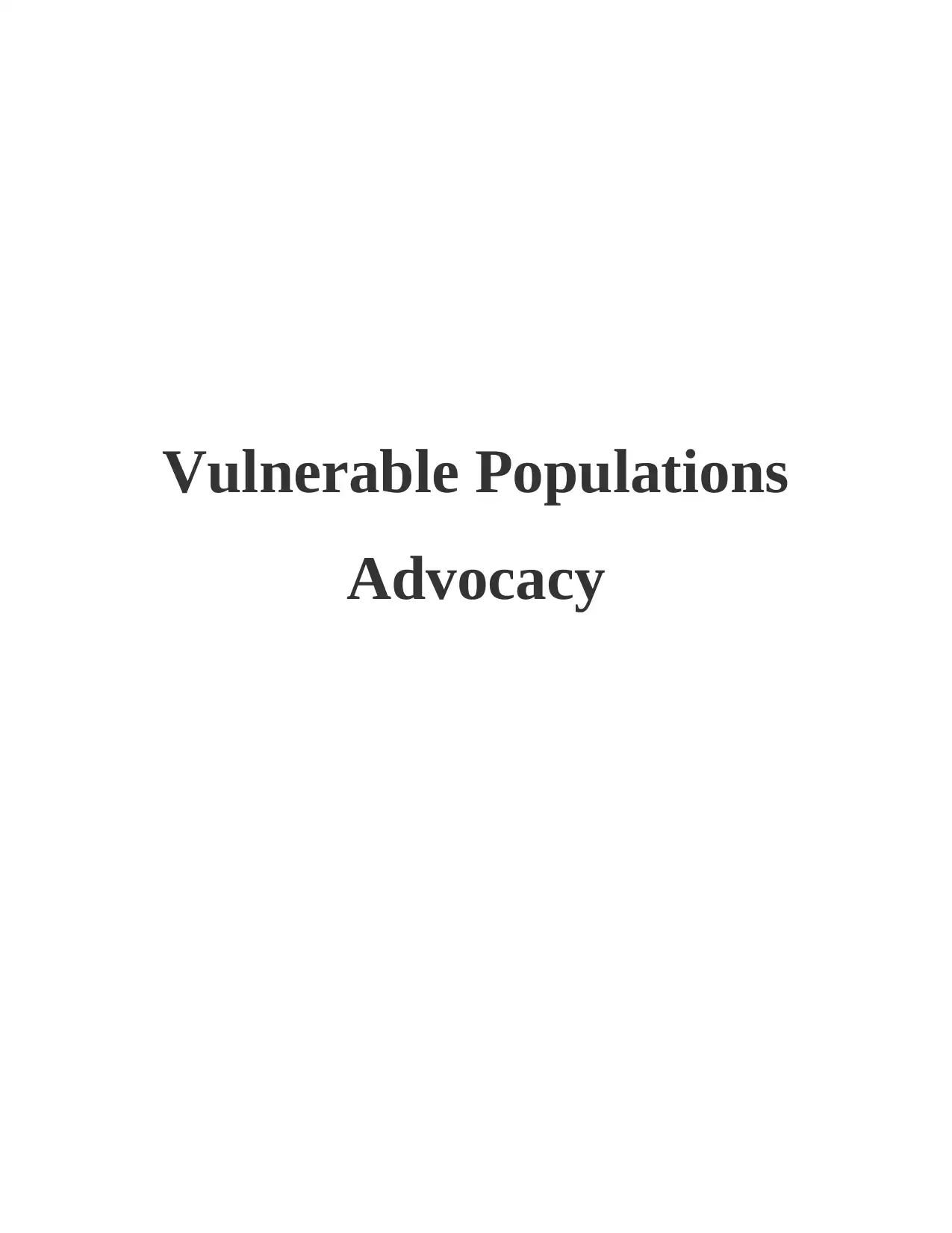
Vulnerable Populations
Advocacy
Advocacy
Secure Best Marks with AI Grader
Need help grading? Try our AI Grader for instant feedback on your assignments.
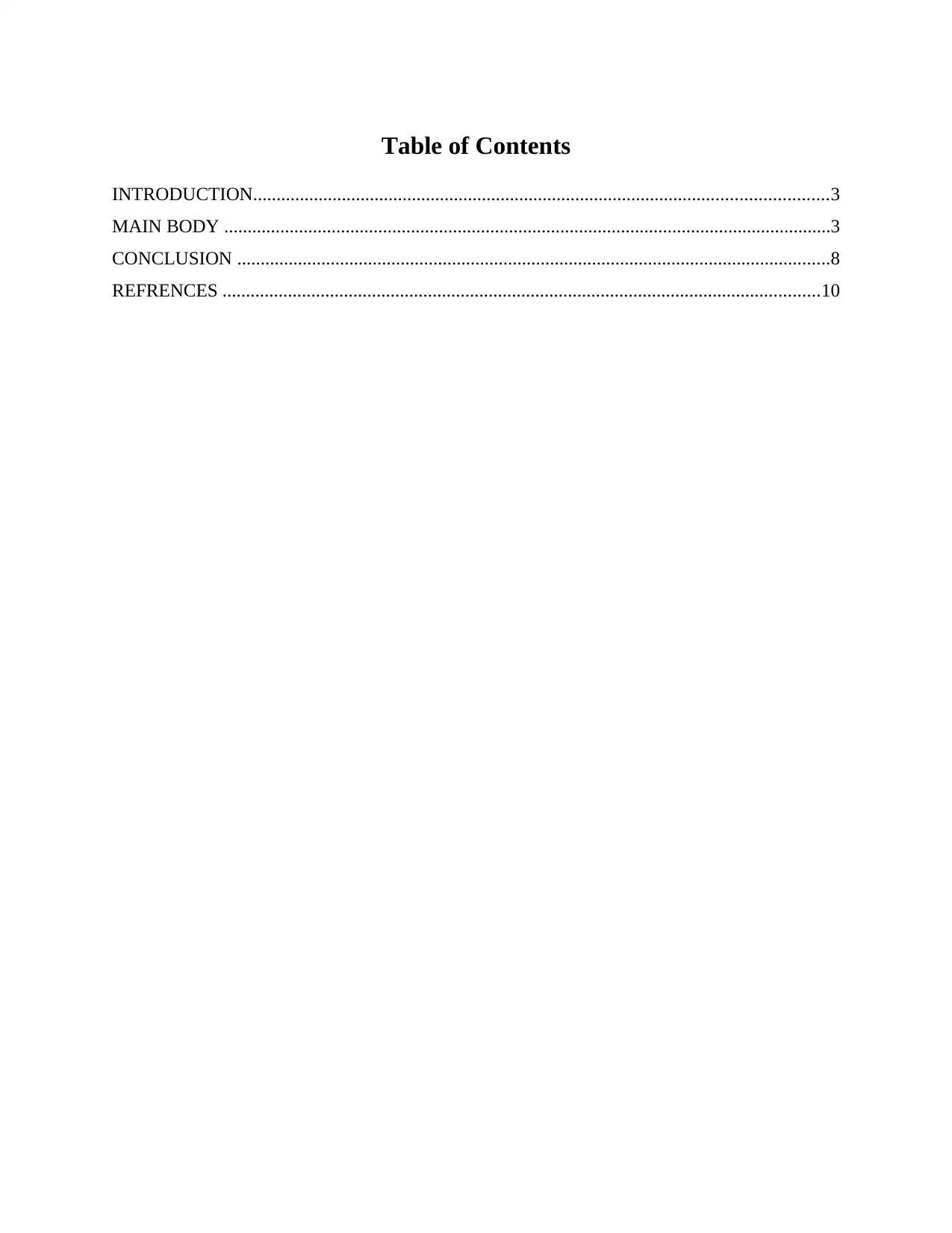
Table of Contents
INTRODUCTION...........................................................................................................................3
MAIN BODY ..................................................................................................................................3
CONCLUSION ...............................................................................................................................8
REFRENCES ................................................................................................................................10
INTRODUCTION...........................................................................................................................3
MAIN BODY ..................................................................................................................................3
CONCLUSION ...............................................................................................................................8
REFRENCES ................................................................................................................................10

INTRODUCTION
Vulnerable populations consists of patients who are ethnic or racial minorities, children,
under-insured, socioeconomically disadvantaged or those with certain medical conditions. They
often have health conditions which are exacerbated by inadequate healthcare. Vulnerable
population can might experience specific benefit from community-level of advocacy efforts due
to influence of social and environmental circumstances on health.
Aboriginal peoples are the peoples who reside in the remote areas of the Australia. They
are suffering from poverty, unhealthy lifestyle, lack of unemployment etc. which tends to suffer
them from mental illness and mental disorder and which become more major due and become
various harmful diseases that can be lung disease, anxiety, chronic diseases, heart stroke and
head injury etc., In the above study evaluation of social determinants is done along with
describing its impact on the aboriginal people. Accessing through health inequalities and health
equities along with the health outcomes with that issues. Further the study carried froward with
the discussion of availability of facilities or services and describing its impact on health. The
report ends with the identification of target audience for making policy decision and allocating
resources and providing recommendations for such.
MAIN BODY
Social determinants of health are conditions in which the people are grown, born, work,
live and age. These circumstances are formed by distribution of resources and power at the
national, global and local levels. Considering aboriginal people as vulnerable populations social
determinants are found for such are as follows -
Criminal Justice–Aboriginal peoples of Australia are specifically presented in the
interactions with criminal justice system. The indigenous population of Australia
consist of overall 3 percent of the population of Australia, by this they form one
quarter of total prison population. They are comprises 40% of people who are
imprisoned for assault charges. Whereas the juvenile justice is also higher, with
indigenous young people who are aged 10-17 years which 24 times more
detained. High rates of the incarcerations which can be viewed as indignant of
Vulnerable populations consists of patients who are ethnic or racial minorities, children,
under-insured, socioeconomically disadvantaged or those with certain medical conditions. They
often have health conditions which are exacerbated by inadequate healthcare. Vulnerable
population can might experience specific benefit from community-level of advocacy efforts due
to influence of social and environmental circumstances on health.
Aboriginal peoples are the peoples who reside in the remote areas of the Australia. They
are suffering from poverty, unhealthy lifestyle, lack of unemployment etc. which tends to suffer
them from mental illness and mental disorder and which become more major due and become
various harmful diseases that can be lung disease, anxiety, chronic diseases, heart stroke and
head injury etc., In the above study evaluation of social determinants is done along with
describing its impact on the aboriginal people. Accessing through health inequalities and health
equities along with the health outcomes with that issues. Further the study carried froward with
the discussion of availability of facilities or services and describing its impact on health. The
report ends with the identification of target audience for making policy decision and allocating
resources and providing recommendations for such.
MAIN BODY
Social determinants of health are conditions in which the people are grown, born, work,
live and age. These circumstances are formed by distribution of resources and power at the
national, global and local levels. Considering aboriginal people as vulnerable populations social
determinants are found for such are as follows -
Criminal Justice–Aboriginal peoples of Australia are specifically presented in the
interactions with criminal justice system. The indigenous population of Australia
consist of overall 3 percent of the population of Australia, by this they form one
quarter of total prison population. They are comprises 40% of people who are
imprisoned for assault charges. Whereas the juvenile justice is also higher, with
indigenous young people who are aged 10-17 years which 24 times more
detained. High rates of the incarcerations which can be viewed as indignant of
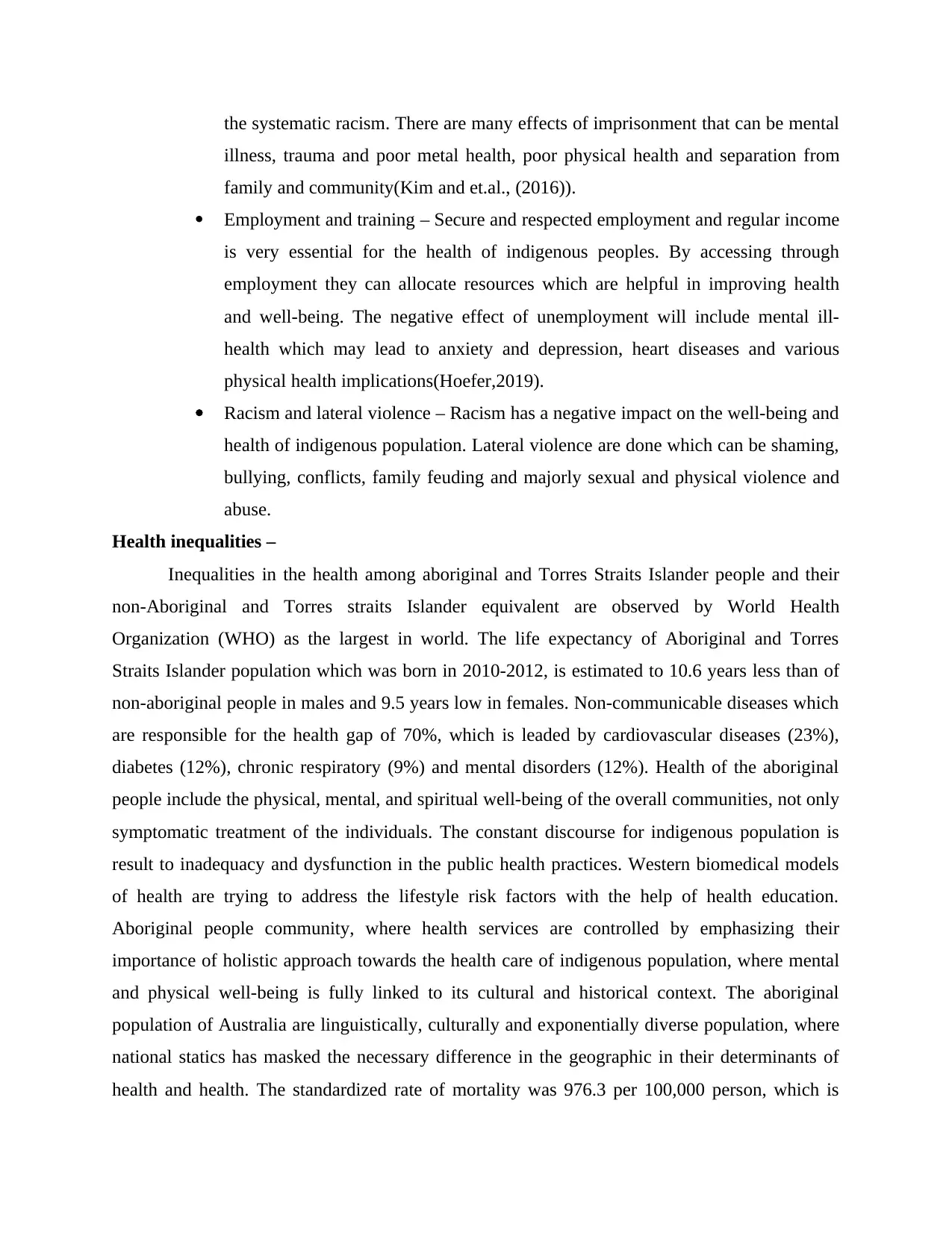
the systematic racism. There are many effects of imprisonment that can be mental
illness, trauma and poor metal health, poor physical health and separation from
family and community(Kim and et.al., (2016)).
Employment and training – Secure and respected employment and regular income
is very essential for the health of indigenous peoples. By accessing through
employment they can allocate resources which are helpful in improving health
and well-being. The negative effect of unemployment will include mental ill-
health which may lead to anxiety and depression, heart diseases and various
physical health implications(Hoefer,2019).
Racism and lateral violence – Racism has a negative impact on the well-being and
health of indigenous population. Lateral violence are done which can be shaming,
bullying, conflicts, family feuding and majorly sexual and physical violence and
abuse.
Health inequalities –
Inequalities in the health among aboriginal and Torres Straits Islander people and their
non-Aboriginal and Torres straits Islander equivalent are observed by World Health
Organization (WHO) as the largest in world. The life expectancy of Aboriginal and Torres
Straits Islander population which was born in 2010-2012, is estimated to 10.6 years less than of
non-aboriginal people in males and 9.5 years low in females. Non-communicable diseases which
are responsible for the health gap of 70%, which is leaded by cardiovascular diseases (23%),
diabetes (12%), chronic respiratory (9%) and mental disorders (12%). Health of the aboriginal
people include the physical, mental, and spiritual well-being of the overall communities, not only
symptomatic treatment of the individuals. The constant discourse for indigenous population is
result to inadequacy and dysfunction in the public health practices. Western biomedical models
of health are trying to address the lifestyle risk factors with the help of health education.
Aboriginal people community, where health services are controlled by emphasizing their
importance of holistic approach towards the health care of indigenous population, where mental
and physical well-being is fully linked to its cultural and historical context. The aboriginal
population of Australia are linguistically, culturally and exponentially diverse population, where
national statics has masked the necessary difference in the geographic in their determinants of
health and health. The standardized rate of mortality was 976.3 per 100,000 person, which is
illness, trauma and poor metal health, poor physical health and separation from
family and community(Kim and et.al., (2016)).
Employment and training – Secure and respected employment and regular income
is very essential for the health of indigenous peoples. By accessing through
employment they can allocate resources which are helpful in improving health
and well-being. The negative effect of unemployment will include mental ill-
health which may lead to anxiety and depression, heart diseases and various
physical health implications(Hoefer,2019).
Racism and lateral violence – Racism has a negative impact on the well-being and
health of indigenous population. Lateral violence are done which can be shaming,
bullying, conflicts, family feuding and majorly sexual and physical violence and
abuse.
Health inequalities –
Inequalities in the health among aboriginal and Torres Straits Islander people and their
non-Aboriginal and Torres straits Islander equivalent are observed by World Health
Organization (WHO) as the largest in world. The life expectancy of Aboriginal and Torres
Straits Islander population which was born in 2010-2012, is estimated to 10.6 years less than of
non-aboriginal people in males and 9.5 years low in females. Non-communicable diseases which
are responsible for the health gap of 70%, which is leaded by cardiovascular diseases (23%),
diabetes (12%), chronic respiratory (9%) and mental disorders (12%). Health of the aboriginal
people include the physical, mental, and spiritual well-being of the overall communities, not only
symptomatic treatment of the individuals. The constant discourse for indigenous population is
result to inadequacy and dysfunction in the public health practices. Western biomedical models
of health are trying to address the lifestyle risk factors with the help of health education.
Aboriginal people community, where health services are controlled by emphasizing their
importance of holistic approach towards the health care of indigenous population, where mental
and physical well-being is fully linked to its cultural and historical context. The aboriginal
population of Australia are linguistically, culturally and exponentially diverse population, where
national statics has masked the necessary difference in the geographic in their determinants of
health and health. The standardized rate of mortality was 976.3 per 100,000 person, which is
Secure Best Marks with AI Grader
Need help grading? Try our AI Grader for instant feedback on your assignments.
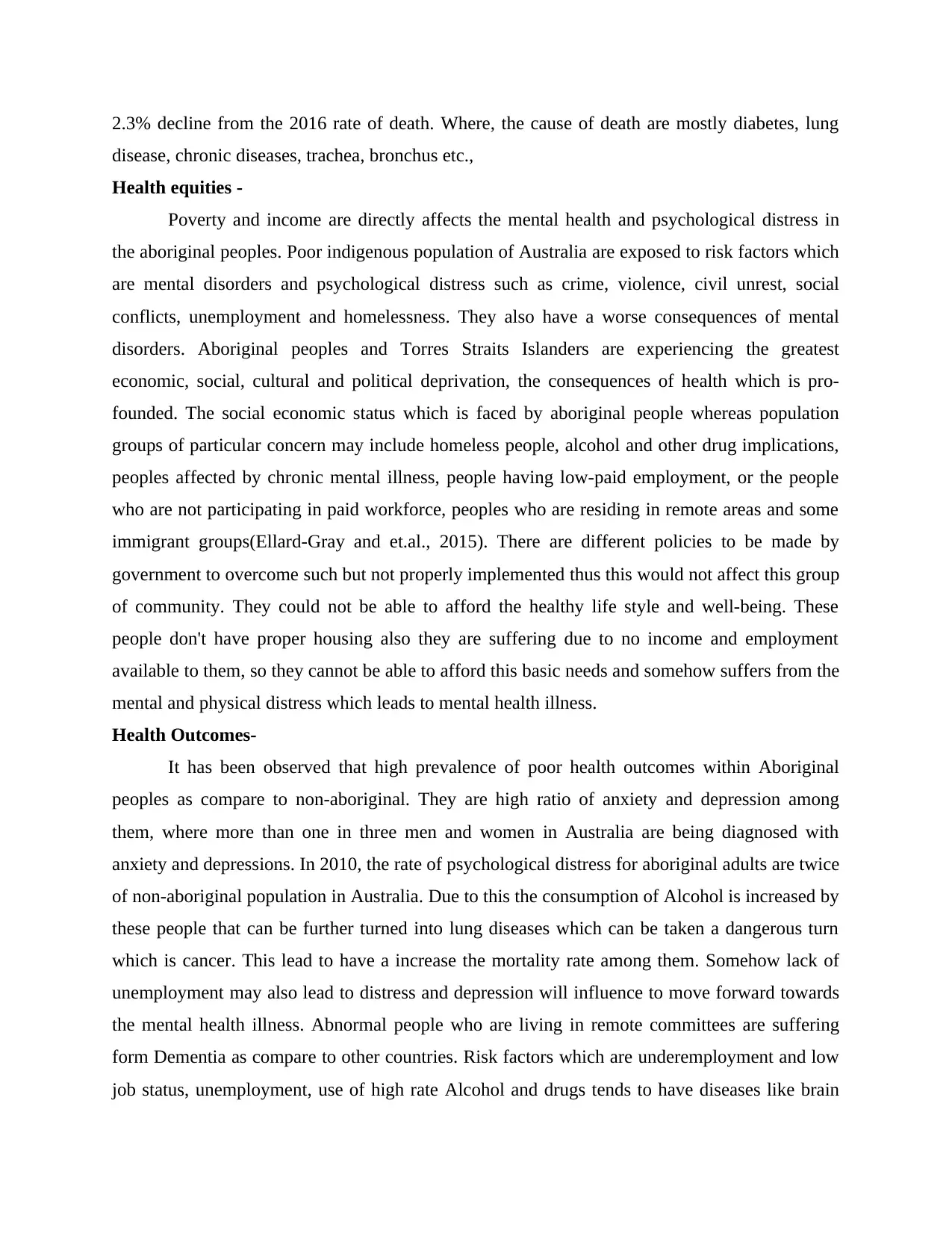
2.3% decline from the 2016 rate of death. Where, the cause of death are mostly diabetes, lung
disease, chronic diseases, trachea, bronchus etc.,
Health equities -
Poverty and income are directly affects the mental health and psychological distress in
the aboriginal peoples. Poor indigenous population of Australia are exposed to risk factors which
are mental disorders and psychological distress such as crime, violence, civil unrest, social
conflicts, unemployment and homelessness. They also have a worse consequences of mental
disorders. Aboriginal peoples and Torres Straits Islanders are experiencing the greatest
economic, social, cultural and political deprivation, the consequences of health which is pro-
founded. The social economic status which is faced by aboriginal people whereas population
groups of particular concern may include homeless people, alcohol and other drug implications,
peoples affected by chronic mental illness, people having low-paid employment, or the people
who are not participating in paid workforce, peoples who are residing in remote areas and some
immigrant groups(Ellard-Gray and et.al., 2015). There are different policies to be made by
government to overcome such but not properly implemented thus this would not affect this group
of community. They could not be able to afford the healthy life style and well-being. These
people don't have proper housing also they are suffering due to no income and employment
available to them, so they cannot be able to afford this basic needs and somehow suffers from the
mental and physical distress which leads to mental health illness.
Health Outcomes-
It has been observed that high prevalence of poor health outcomes within Aboriginal
peoples as compare to non-aboriginal. They are high ratio of anxiety and depression among
them, where more than one in three men and women in Australia are being diagnosed with
anxiety and depressions. In 2010, the rate of psychological distress for aboriginal adults are twice
of non-aboriginal population in Australia. Due to this the consumption of Alcohol is increased by
these people that can be further turned into lung diseases which can be taken a dangerous turn
which is cancer. This lead to have a increase the mortality rate among them. Somehow lack of
unemployment may also lead to distress and depression will influence to move forward towards
the mental health illness. Abnormal people who are living in remote committees are suffering
form Dementia as compare to other countries. Risk factors which are underemployment and low
job status, unemployment, use of high rate Alcohol and drugs tends to have diseases like brain
disease, chronic diseases, trachea, bronchus etc.,
Health equities -
Poverty and income are directly affects the mental health and psychological distress in
the aboriginal peoples. Poor indigenous population of Australia are exposed to risk factors which
are mental disorders and psychological distress such as crime, violence, civil unrest, social
conflicts, unemployment and homelessness. They also have a worse consequences of mental
disorders. Aboriginal peoples and Torres Straits Islanders are experiencing the greatest
economic, social, cultural and political deprivation, the consequences of health which is pro-
founded. The social economic status which is faced by aboriginal people whereas population
groups of particular concern may include homeless people, alcohol and other drug implications,
peoples affected by chronic mental illness, people having low-paid employment, or the people
who are not participating in paid workforce, peoples who are residing in remote areas and some
immigrant groups(Ellard-Gray and et.al., 2015). There are different policies to be made by
government to overcome such but not properly implemented thus this would not affect this group
of community. They could not be able to afford the healthy life style and well-being. These
people don't have proper housing also they are suffering due to no income and employment
available to them, so they cannot be able to afford this basic needs and somehow suffers from the
mental and physical distress which leads to mental health illness.
Health Outcomes-
It has been observed that high prevalence of poor health outcomes within Aboriginal
peoples as compare to non-aboriginal. They are high ratio of anxiety and depression among
them, where more than one in three men and women in Australia are being diagnosed with
anxiety and depressions. In 2010, the rate of psychological distress for aboriginal adults are twice
of non-aboriginal population in Australia. Due to this the consumption of Alcohol is increased by
these people that can be further turned into lung diseases which can be taken a dangerous turn
which is cancer. This lead to have a increase the mortality rate among them. Somehow lack of
unemployment may also lead to distress and depression will influence to move forward towards
the mental health illness. Abnormal people who are living in remote committees are suffering
form Dementia as compare to other countries. Risk factors which are underemployment and low
job status, unemployment, use of high rate Alcohol and drugs tends to have diseases like brain
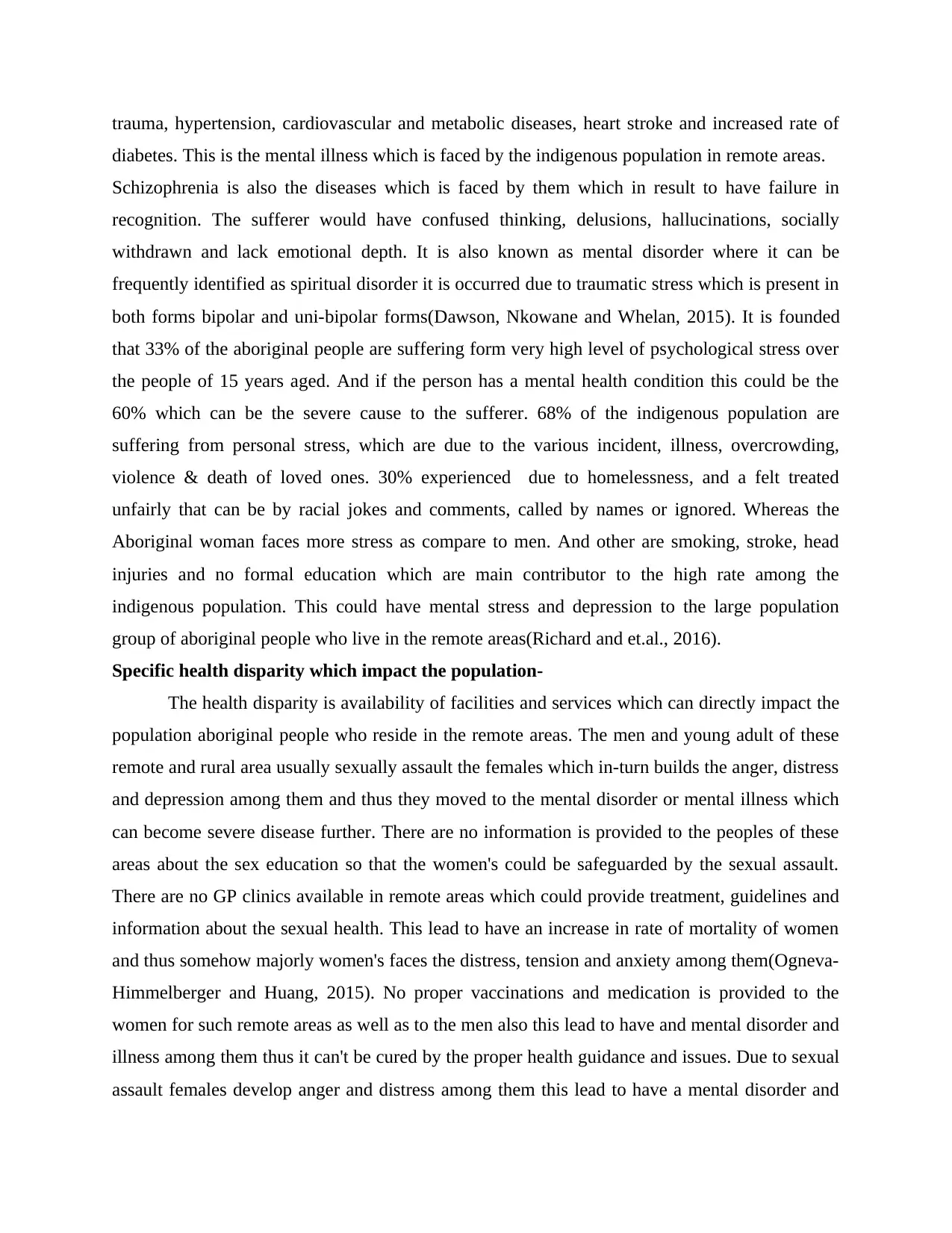
trauma, hypertension, cardiovascular and metabolic diseases, heart stroke and increased rate of
diabetes. This is the mental illness which is faced by the indigenous population in remote areas.
Schizophrenia is also the diseases which is faced by them which in result to have failure in
recognition. The sufferer would have confused thinking, delusions, hallucinations, socially
withdrawn and lack emotional depth. It is also known as mental disorder where it can be
frequently identified as spiritual disorder it is occurred due to traumatic stress which is present in
both forms bipolar and uni-bipolar forms(Dawson, Nkowane and Whelan, 2015). It is founded
that 33% of the aboriginal people are suffering form very high level of psychological stress over
the people of 15 years aged. And if the person has a mental health condition this could be the
60% which can be the severe cause to the sufferer. 68% of the indigenous population are
suffering from personal stress, which are due to the various incident, illness, overcrowding,
violence & death of loved ones. 30% experienced due to homelessness, and a felt treated
unfairly that can be by racial jokes and comments, called by names or ignored. Whereas the
Aboriginal woman faces more stress as compare to men. And other are smoking, stroke, head
injuries and no formal education which are main contributor to the high rate among the
indigenous population. This could have mental stress and depression to the large population
group of aboriginal people who live in the remote areas(Richard and et.al., 2016).
Specific health disparity which impact the population-
The health disparity is availability of facilities and services which can directly impact the
population aboriginal people who reside in the remote areas. The men and young adult of these
remote and rural area usually sexually assault the females which in-turn builds the anger, distress
and depression among them and thus they moved to the mental disorder or mental illness which
can become severe disease further. There are no information is provided to the peoples of these
areas about the sex education so that the women's could be safeguarded by the sexual assault.
There are no GP clinics available in remote areas which could provide treatment, guidelines and
information about the sexual health. This lead to have an increase in rate of mortality of women
and thus somehow majorly women's faces the distress, tension and anxiety among them(Ogneva-
Himmelberger and Huang, 2015). No proper vaccinations and medication is provided to the
women for such remote areas as well as to the men also this lead to have and mental disorder and
illness among them thus it can't be cured by the proper health guidance and issues. Due to sexual
assault females develop anger and distress among them this lead to have a mental disorder and
diabetes. This is the mental illness which is faced by the indigenous population in remote areas.
Schizophrenia is also the diseases which is faced by them which in result to have failure in
recognition. The sufferer would have confused thinking, delusions, hallucinations, socially
withdrawn and lack emotional depth. It is also known as mental disorder where it can be
frequently identified as spiritual disorder it is occurred due to traumatic stress which is present in
both forms bipolar and uni-bipolar forms(Dawson, Nkowane and Whelan, 2015). It is founded
that 33% of the aboriginal people are suffering form very high level of psychological stress over
the people of 15 years aged. And if the person has a mental health condition this could be the
60% which can be the severe cause to the sufferer. 68% of the indigenous population are
suffering from personal stress, which are due to the various incident, illness, overcrowding,
violence & death of loved ones. 30% experienced due to homelessness, and a felt treated
unfairly that can be by racial jokes and comments, called by names or ignored. Whereas the
Aboriginal woman faces more stress as compare to men. And other are smoking, stroke, head
injuries and no formal education which are main contributor to the high rate among the
indigenous population. This could have mental stress and depression to the large population
group of aboriginal people who live in the remote areas(Richard and et.al., 2016).
Specific health disparity which impact the population-
The health disparity is availability of facilities and services which can directly impact the
population aboriginal people who reside in the remote areas. The men and young adult of these
remote and rural area usually sexually assault the females which in-turn builds the anger, distress
and depression among them and thus they moved to the mental disorder or mental illness which
can become severe disease further. There are no information is provided to the peoples of these
areas about the sex education so that the women's could be safeguarded by the sexual assault.
There are no GP clinics available in remote areas which could provide treatment, guidelines and
information about the sexual health. This lead to have an increase in rate of mortality of women
and thus somehow majorly women's faces the distress, tension and anxiety among them(Ogneva-
Himmelberger and Huang, 2015). No proper vaccinations and medication is provided to the
women for such remote areas as well as to the men also this lead to have and mental disorder and
illness among them thus it can't be cured by the proper health guidance and issues. Due to sexual
assault females develop anger and distress among them this lead to have a mental disorder and

illness in them which is harmful for their health. This could also lead depression which can lead
to head injuries, brain tumor or a heart stroke. There is no proper medical professionals and
doctor who could guide them. And lack of education leads to have a no awareness about the
things that should be recommended. The lack of housing and unemployment can also redirect
them to distress and depression and mental illness, and then they move towards adopting such
bad practices that are drinking alcohol, smoking, sexually assaulting females, abusing, becoming
violent etc(Stanhope and Lancaster, 2015).,
Impact of health -
There are poor health facilities which are rendered by the health professionals they lack
behind sue to the discrimination done by the local people to them. They couldn't be able to
provide proper guidance to the local remote aboriginal people(Douthit and Biswas, 2018). As,
these people are not getting proper guidance and information about health care they couldn't be
avail through a healthy lifestyle which in result to have a severe health diseases which can be
chronic diseases, trauma, heart stroke, anxiety, lungs disease and head injuries which is in result
by mental disorder and mental illness. The indigenous people are facing mental health issues due
to lack of healthcare guidance as due to discrimination women fears to go a take preventive
measures from the health professionals which bounds them to go and are issues which are faced
by them due to sexual assault which in further lead to develop cancer or any dangerous disease.
Due to lack of health screening the patients are not availed through various treatments,
prevention and vaccinations which can protect them from further diseases when they are not
healthy they have developed the mental stress and distress among them and afterwards tends to
have a major disease(Farrer and et.al., 2015).
The homeless people, unemployed people, sexually assault people tend to develop the
feeling of anger, distress and depression in them that's the reason by which day by day the death
rate of peoples in the indigenous population is going to be increase rapidly. The Australian
government should make preventive policies and measures for such group of people so that they
can prevent these group from such severe diseases and avails them with the overall guidance on
the healthcare and safe practices which should be adopted by them. If this must be done then
they can reduce the rate of the mortality along with the rate of morbidity which can raise the all
issues that are faced by the indigenous population as they have a severe impact on their health
issues. Along with this proper guidance must be provided to the men and women's about safe sex
to head injuries, brain tumor or a heart stroke. There is no proper medical professionals and
doctor who could guide them. And lack of education leads to have a no awareness about the
things that should be recommended. The lack of housing and unemployment can also redirect
them to distress and depression and mental illness, and then they move towards adopting such
bad practices that are drinking alcohol, smoking, sexually assaulting females, abusing, becoming
violent etc(Stanhope and Lancaster, 2015).,
Impact of health -
There are poor health facilities which are rendered by the health professionals they lack
behind sue to the discrimination done by the local people to them. They couldn't be able to
provide proper guidance to the local remote aboriginal people(Douthit and Biswas, 2018). As,
these people are not getting proper guidance and information about health care they couldn't be
avail through a healthy lifestyle which in result to have a severe health diseases which can be
chronic diseases, trauma, heart stroke, anxiety, lungs disease and head injuries which is in result
by mental disorder and mental illness. The indigenous people are facing mental health issues due
to lack of healthcare guidance as due to discrimination women fears to go a take preventive
measures from the health professionals which bounds them to go and are issues which are faced
by them due to sexual assault which in further lead to develop cancer or any dangerous disease.
Due to lack of health screening the patients are not availed through various treatments,
prevention and vaccinations which can protect them from further diseases when they are not
healthy they have developed the mental stress and distress among them and afterwards tends to
have a major disease(Farrer and et.al., 2015).
The homeless people, unemployed people, sexually assault people tend to develop the
feeling of anger, distress and depression in them that's the reason by which day by day the death
rate of peoples in the indigenous population is going to be increase rapidly. The Australian
government should make preventive policies and measures for such group of people so that they
can prevent these group from such severe diseases and avails them with the overall guidance on
the healthcare and safe practices which should be adopted by them. If this must be done then
they can reduce the rate of the mortality along with the rate of morbidity which can raise the all
issues that are faced by the indigenous population as they have a severe impact on their health
issues. Along with this proper guidance must be provided to the men and women's about safe sex
Paraphrase This Document
Need a fresh take? Get an instant paraphrase of this document with our AI Paraphraser
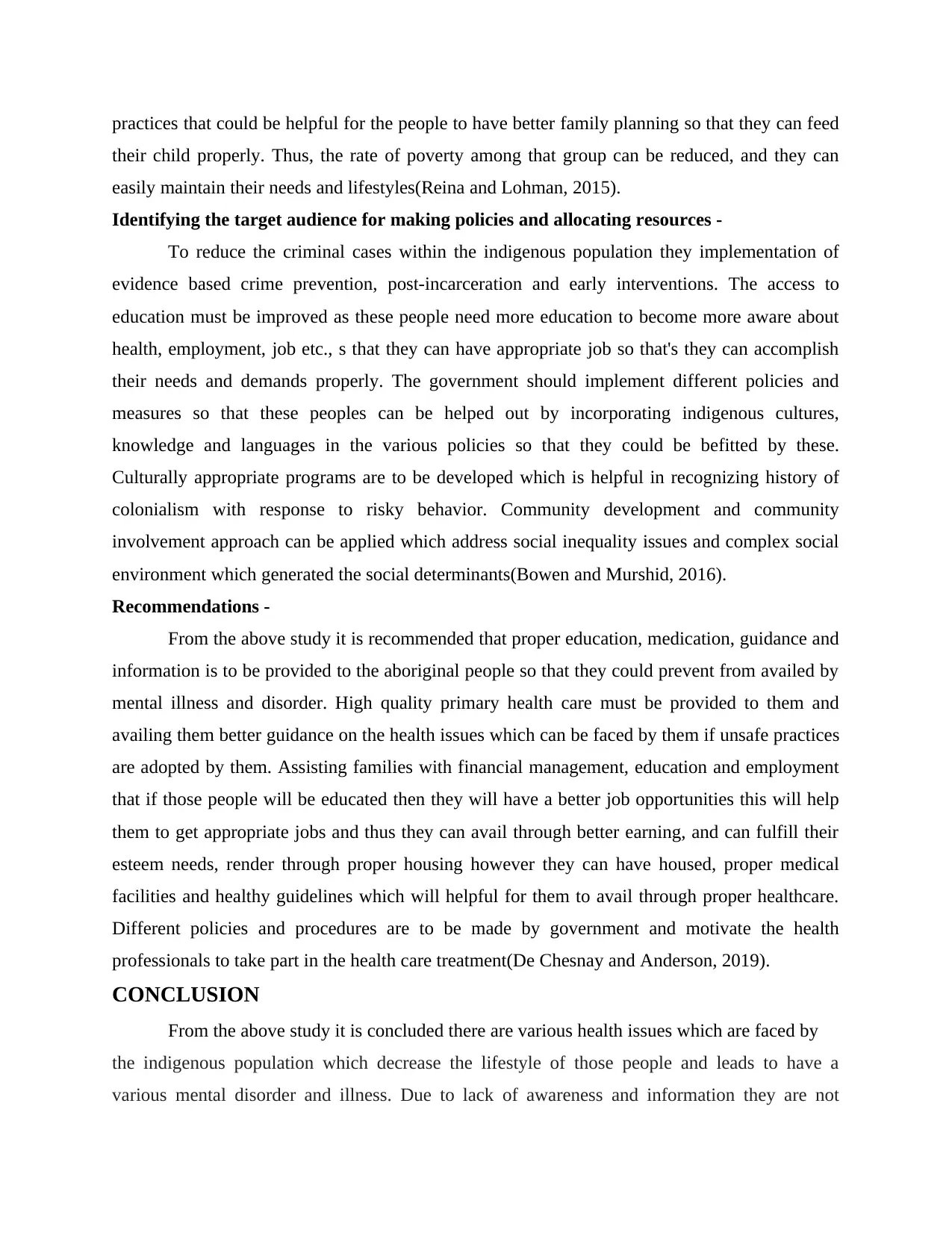
practices that could be helpful for the people to have better family planning so that they can feed
their child properly. Thus, the rate of poverty among that group can be reduced, and they can
easily maintain their needs and lifestyles(Reina and Lohman, 2015).
Identifying the target audience for making policies and allocating resources -
To reduce the criminal cases within the indigenous population they implementation of
evidence based crime prevention, post-incarceration and early interventions. The access to
education must be improved as these people need more education to become more aware about
health, employment, job etc., s that they can have appropriate job so that's they can accomplish
their needs and demands properly. The government should implement different policies and
measures so that these peoples can be helped out by incorporating indigenous cultures,
knowledge and languages in the various policies so that they could be befitted by these.
Culturally appropriate programs are to be developed which is helpful in recognizing history of
colonialism with response to risky behavior. Community development and community
involvement approach can be applied which address social inequality issues and complex social
environment which generated the social determinants(Bowen and Murshid, 2016).
Recommendations -
From the above study it is recommended that proper education, medication, guidance and
information is to be provided to the aboriginal people so that they could prevent from availed by
mental illness and disorder. High quality primary health care must be provided to them and
availing them better guidance on the health issues which can be faced by them if unsafe practices
are adopted by them. Assisting families with financial management, education and employment
that if those people will be educated then they will have a better job opportunities this will help
them to get appropriate jobs and thus they can avail through better earning, and can fulfill their
esteem needs, render through proper housing however they can have housed, proper medical
facilities and healthy guidelines which will helpful for them to avail through proper healthcare.
Different policies and procedures are to be made by government and motivate the health
professionals to take part in the health care treatment(De Chesnay and Anderson, 2019).
CONCLUSION
From the above study it is concluded there are various health issues which are faced by
the indigenous population which decrease the lifestyle of those people and leads to have a
various mental disorder and illness. Due to lack of awareness and information they are not
their child properly. Thus, the rate of poverty among that group can be reduced, and they can
easily maintain their needs and lifestyles(Reina and Lohman, 2015).
Identifying the target audience for making policies and allocating resources -
To reduce the criminal cases within the indigenous population they implementation of
evidence based crime prevention, post-incarceration and early interventions. The access to
education must be improved as these people need more education to become more aware about
health, employment, job etc., s that they can have appropriate job so that's they can accomplish
their needs and demands properly. The government should implement different policies and
measures so that these peoples can be helped out by incorporating indigenous cultures,
knowledge and languages in the various policies so that they could be befitted by these.
Culturally appropriate programs are to be developed which is helpful in recognizing history of
colonialism with response to risky behavior. Community development and community
involvement approach can be applied which address social inequality issues and complex social
environment which generated the social determinants(Bowen and Murshid, 2016).
Recommendations -
From the above study it is recommended that proper education, medication, guidance and
information is to be provided to the aboriginal people so that they could prevent from availed by
mental illness and disorder. High quality primary health care must be provided to them and
availing them better guidance on the health issues which can be faced by them if unsafe practices
are adopted by them. Assisting families with financial management, education and employment
that if those people will be educated then they will have a better job opportunities this will help
them to get appropriate jobs and thus they can avail through better earning, and can fulfill their
esteem needs, render through proper housing however they can have housed, proper medical
facilities and healthy guidelines which will helpful for them to avail through proper healthcare.
Different policies and procedures are to be made by government and motivate the health
professionals to take part in the health care treatment(De Chesnay and Anderson, 2019).
CONCLUSION
From the above study it is concluded there are various health issues which are faced by
the indigenous population which decrease the lifestyle of those people and leads to have a
various mental disorder and illness. Due to lack of awareness and information they are not
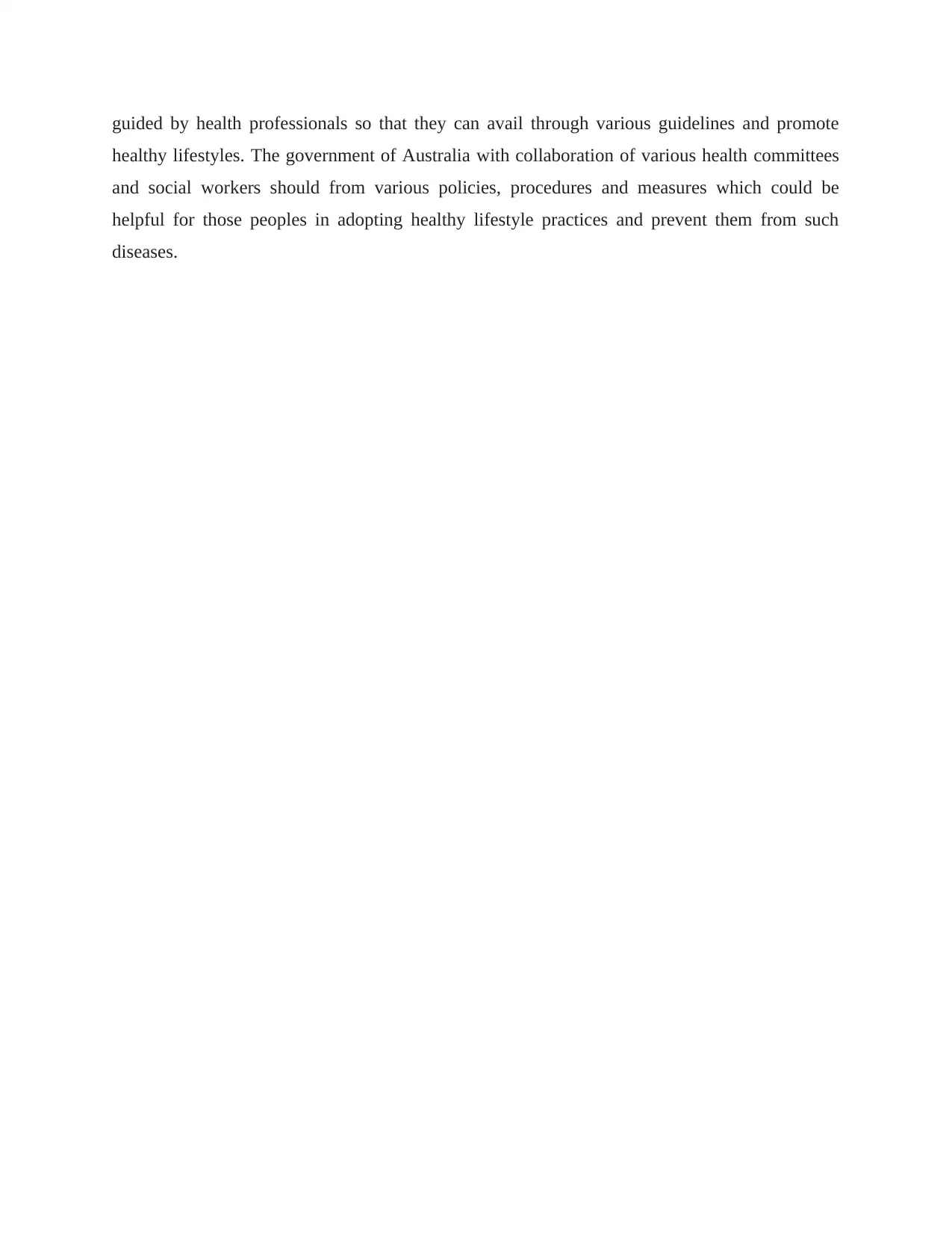
guided by health professionals so that they can avail through various guidelines and promote
healthy lifestyles. The government of Australia with collaboration of various health committees
and social workers should from various policies, procedures and measures which could be
helpful for those peoples in adopting healthy lifestyle practices and prevent them from such
diseases.
healthy lifestyles. The government of Australia with collaboration of various health committees
and social workers should from various policies, procedures and measures which could be
helpful for those peoples in adopting healthy lifestyle practices and prevent them from such
diseases.
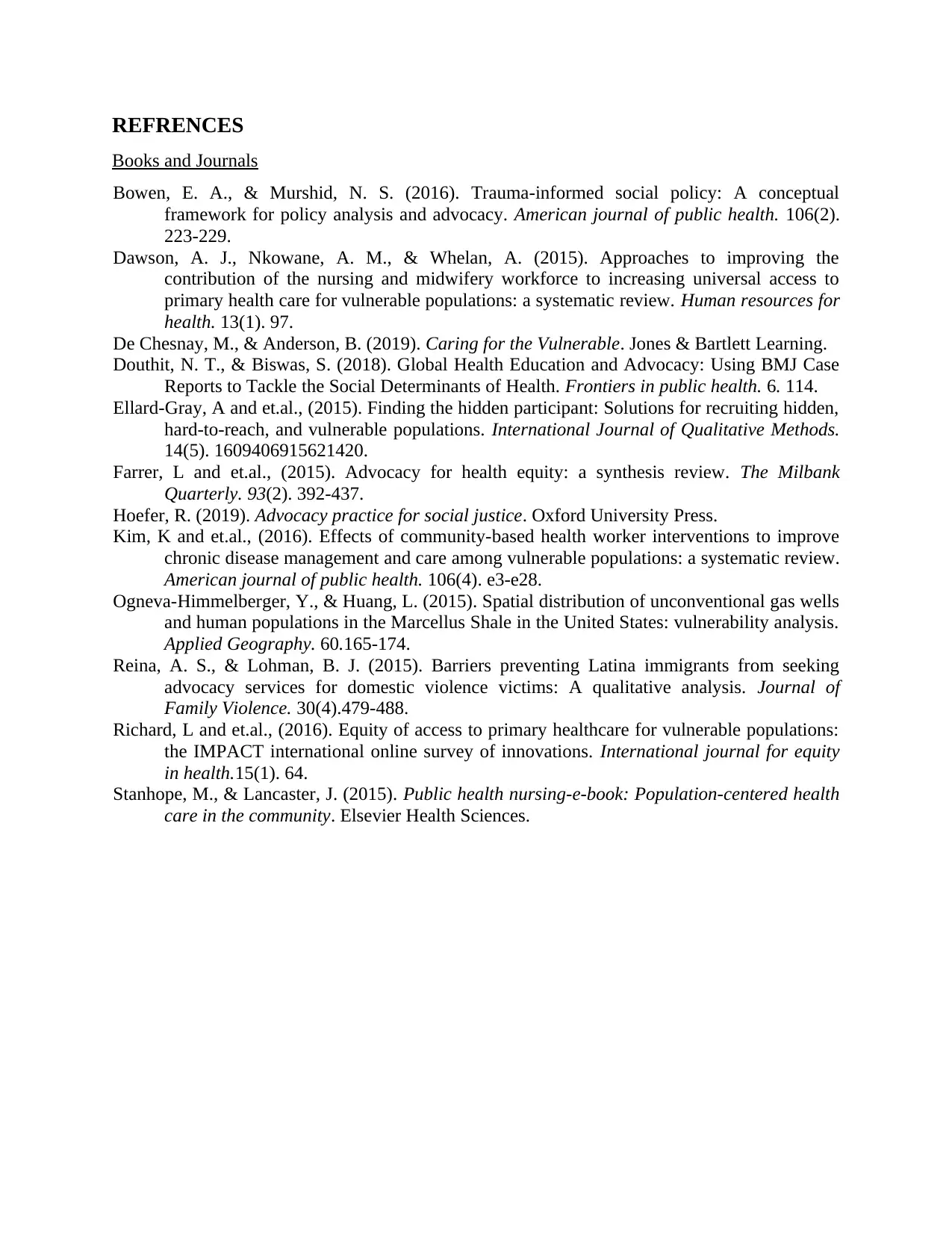
REFRENCES
Books and Journals
Bowen, E. A., & Murshid, N. S. (2016). Trauma-informed social policy: A conceptual
framework for policy analysis and advocacy. American journal of public health. 106(2).
223-229.
Dawson, A. J., Nkowane, A. M., & Whelan, A. (2015). Approaches to improving the
contribution of the nursing and midwifery workforce to increasing universal access to
primary health care for vulnerable populations: a systematic review. Human resources for
health. 13(1). 97.
De Chesnay, M., & Anderson, B. (2019). Caring for the Vulnerable. Jones & Bartlett Learning.
Douthit, N. T., & Biswas, S. (2018). Global Health Education and Advocacy: Using BMJ Case
Reports to Tackle the Social Determinants of Health. Frontiers in public health. 6. 114.
Ellard-Gray, A and et.al., (2015). Finding the hidden participant: Solutions for recruiting hidden,
hard-to-reach, and vulnerable populations. International Journal of Qualitative Methods.
14(5). 1609406915621420.
Farrer, L and et.al., (2015). Advocacy for health equity: a synthesis review. The Milbank
Quarterly. 93(2). 392-437.
Hoefer, R. (2019). Advocacy practice for social justice. Oxford University Press.
Kim, K and et.al., (2016). Effects of community-based health worker interventions to improve
chronic disease management and care among vulnerable populations: a systematic review.
American journal of public health. 106(4). e3-e28.
Ogneva-Himmelberger, Y., & Huang, L. (2015). Spatial distribution of unconventional gas wells
and human populations in the Marcellus Shale in the United States: vulnerability analysis.
Applied Geography. 60.165-174.
Reina, A. S., & Lohman, B. J. (2015). Barriers preventing Latina immigrants from seeking
advocacy services for domestic violence victims: A qualitative analysis. Journal of
Family Violence. 30(4).479-488.
Richard, L and et.al., (2016). Equity of access to primary healthcare for vulnerable populations:
the IMPACT international online survey of innovations. International journal for equity
in health.15(1). 64.
Stanhope, M., & Lancaster, J. (2015). Public health nursing-e-book: Population-centered health
care in the community. Elsevier Health Sciences.
Books and Journals
Bowen, E. A., & Murshid, N. S. (2016). Trauma-informed social policy: A conceptual
framework for policy analysis and advocacy. American journal of public health. 106(2).
223-229.
Dawson, A. J., Nkowane, A. M., & Whelan, A. (2015). Approaches to improving the
contribution of the nursing and midwifery workforce to increasing universal access to
primary health care for vulnerable populations: a systematic review. Human resources for
health. 13(1). 97.
De Chesnay, M., & Anderson, B. (2019). Caring for the Vulnerable. Jones & Bartlett Learning.
Douthit, N. T., & Biswas, S. (2018). Global Health Education and Advocacy: Using BMJ Case
Reports to Tackle the Social Determinants of Health. Frontiers in public health. 6. 114.
Ellard-Gray, A and et.al., (2015). Finding the hidden participant: Solutions for recruiting hidden,
hard-to-reach, and vulnerable populations. International Journal of Qualitative Methods.
14(5). 1609406915621420.
Farrer, L and et.al., (2015). Advocacy for health equity: a synthesis review. The Milbank
Quarterly. 93(2). 392-437.
Hoefer, R. (2019). Advocacy practice for social justice. Oxford University Press.
Kim, K and et.al., (2016). Effects of community-based health worker interventions to improve
chronic disease management and care among vulnerable populations: a systematic review.
American journal of public health. 106(4). e3-e28.
Ogneva-Himmelberger, Y., & Huang, L. (2015). Spatial distribution of unconventional gas wells
and human populations in the Marcellus Shale in the United States: vulnerability analysis.
Applied Geography. 60.165-174.
Reina, A. S., & Lohman, B. J. (2015). Barriers preventing Latina immigrants from seeking
advocacy services for domestic violence victims: A qualitative analysis. Journal of
Family Violence. 30(4).479-488.
Richard, L and et.al., (2016). Equity of access to primary healthcare for vulnerable populations:
the IMPACT international online survey of innovations. International journal for equity
in health.15(1). 64.
Stanhope, M., & Lancaster, J. (2015). Public health nursing-e-book: Population-centered health
care in the community. Elsevier Health Sciences.
1 out of 10
Related Documents
Your All-in-One AI-Powered Toolkit for Academic Success.
+13062052269
info@desklib.com
Available 24*7 on WhatsApp / Email
![[object Object]](/_next/static/media/star-bottom.7253800d.svg)
Unlock your academic potential
© 2024 | Zucol Services PVT LTD | All rights reserved.





